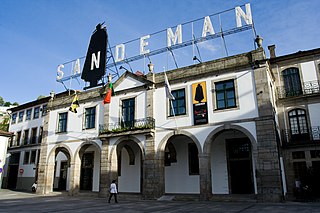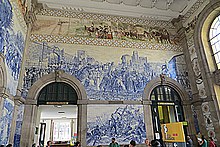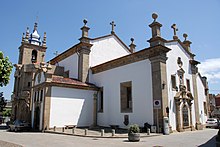
Chaves is a city and a municipality in the north of Portugal. It is 10 km south of the Spanish border and 22 km south of Verín (Spain). The population in 2011 was 41,243, in an area of 591.23 km2. The municipality is the second most populous of the district of Vila Real. With origins in the Roman civitas Aquæ Flaviæ, Chaves has developed into a regional center. The urban area has 17,535 residents (2001).
A dos Francos is one of twelve civil parishes (freguesias) in the municipality of Caldas da Rainha, Portugal. The population in 2011 was 1,701, in an area of 18.93 km². It includes the settlements A dos Francos, Broeiras, Carreiros, Casais da Aramanha, Casais da Bica, Casais da Paraventa, Casais de Santa Helena, Casais Gaiolas, Casal da Palmeira, Casal das Cheiras, Casal das Sesmarias, Casal Sobreiro, Casal Pinheiro, Casal Val Covo, Salgueirinha, Santa Susana and Vila Verde de Matos.

Vila Nova de Gaia, or simply Gaia, is a city and a municipality in Porto District in Norte Region, Portugal. It is located south of the city of Porto on the other side of the Douro River. The city proper had a population of 178,255 in 2001. The municipality has an area of 168.46 km². and a total population of 302,295 inhabitants (2011), making it the most populous municipality in Norte Region. Gaia along with Porto and 12 other municipalities make up the commonly designated Porto Metropolitan Area.

Vila do Porto is the single municipality, the name of the main town and one of the civil parishes on the island of Santa Maria, in the Portuguese archipelago of Azores. Its nearest neighbor, administratively, is the municipality of Povoação on the southern coast of São Miguel, and it is physically southwest of the islets of the Formigas. The population in 2021 was 5,408, in an area of 96.89 km2 (37.41 sq mi).

Vila de São Sebastião, commonly shortened to São Sebastião, is a civil parish in the municipality of Angra do Heroísmo, on the island of Terceira in the Portuguese archipelago of the Azores. The population in 2011 was 2,096, in an area of 23.93 square kilometres (9.24 sq mi). It is in the southeastern part of the island of Terceira. It contains the localities Arrabalde, Boavista, Cavalas, Canada da Salga, Contendas, Cruz, Maria Vieira, Ribeira Seca de Cima, Ribeira Seca de Baixo, Salgueiros and Vila de São Sebastião.

Aljustrel is a town and a municipality in the Portuguese district of Beja. The population in 2011 was 9,257, in an area of 458.47 km2. The present mayor is Nelson Domingos Brito, elected by the Socialist Party. The municipal holiday is June 13.

Cartaxo is a municipality in the district of Santarém in continental Portugal. The population in 2011 was 24,462, in an area of 158.17 km². The urbanized centre of Cartaxo had a population of 9,507 in 2001.

Mira is a municipality in the central Portuguese district of Coimbra. A coastal municipality, known for its beaches, forests, and agriculture, the population was 12,465 inhabitants in an area of approximately 124.03 square kilometres (47.89 sq mi).

Penafiel ([pɨnɐfiˈɛl]or is a municipality and former bishopric in the northern Portuguese district of Porto. Capital of the Tâmega Subregion, the population was 72,265 in 2011, in an area of 212.24 square kilometres.

Batalha is a town and a municipality in Leiria District, Pinhal Litoral Subregion, Centro Region, Portugal. The town's name means "battle". The municipality population in 2011 was 15,805, in an area of 103.42 km2 (39.93 sq mi). The town proper has around 8,548 inhabitants in an area of 28.42 km2 (10.97 sq mi). The municipality is limited to the North and West by the municipality of Leiria, to the East by Ourém, to the Southeast by Alcanena and to the Southwest by Porto de Mós.

Vila do Porto is a civil parish in the municipality of Vila do Porto, located on the island of Santa Maria, in the Portuguese autonomous region of Azores. It is the southernmost and easternmost parish in the archipelago of Azores. The population in 2011 was 3,119, in an area of 25.55 km².

Sabará is a Brazilian municipality located in the state of Minas Gerais. The city belongs to the Belo Horizonte metropolitan region and to the associated microregion.
Albuquerque Mendes is a Portuguese artist. He works in the fields of painting, performance art and installation.
Braga is a civil parish in the municipality of Braga, Portugal. It was formed in 2013 by the merger of the former parishes Maximinos, Sé and Cividade. The population in 2011 was 14,572, in an area of 2.57 km².

Mexilhoeira Grande is a civil parish in the municipality (concelho) of Portimão in the southern Portuguese region of the Algarve. The population in 2011 was 4,029, in an area of 91.15 km².

Igreja dos Grilos is a church and convent in Porto, Portugal.

A Church of the Santa Casa da Misericórdia, sometime referred to as the Church of Our Lady of Mercy, is a 17th-century church in the civil parish of Penafiel, in the municipality of the same name, in the Portuguese district of Porto.
Vila Nova de Gaia is one of the leading tourism destinations in northern Portugal, located directly opposite Porto, on the South bank of Douro river. These two cities interconnect with each other through several bridges over Douro river. Vila Nova de Gaia is home to several notable attractions, such as the Port wine cellars, Dom Luís I Bridge, the Teleferico, Monastery of Serra do Pilar, Douro Estuary and 18 km long beaches.






































